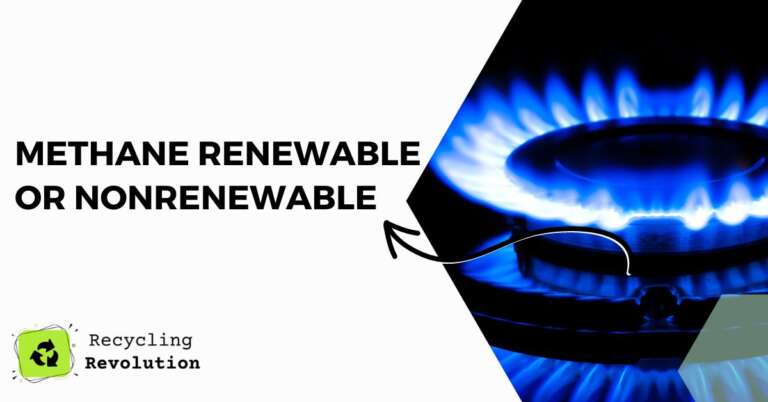Hello, dear renewable enthusiest! Let’s dive deep into the world of methane – a topic that has gained much attention in recent times.
tl;dr: Methane can be both renewable and nonrenewable. While the majority of methane emissions are from nonrenewable sources such as fossil fuels, renewable sources like biogas from landfills and livestock are emerging. The key is to understand the difference and manage its impact on our environment.
The Basics of Methane
Methane, or CH₄, is a powerful greenhouse gas that’s over 25 times more effective at trapping heat in the atmosphere than carbon dioxide over a 100-year period. That’s a big deal. Its sources are varied, and that’s where the confusion often lies.
Renewable Methane: The New Hope
When we talk about renewable methane, we’re primarily discussing biogas. Here’s why it’s exciting:
- Organic Origins: Biogas is produced when organic matter decays in the absence of oxygen. Think of landfills, wastewater treatment, or even our cow friends passing wind!
- Circular Energy: It’s renewable because we can keep producing waste (let’s be honest, humans are great at that). As long as there’s organic decay, there’s potential for biogas.
- Carbon Neutral Potential: When methane from biogas is burned, it releases carbon dioxide. However, this carbon dioxide was recently in the atmosphere and taken up by plants, so it’s often considered carbon neutral.
I recommend homeowners to consider investing in small-scale biodigesters. Not only can these reduce organic waste, but they can also produce a sustainable source of energy for heating or cooking!
Nonrenewable Methane: The Persistent Problem
Now, the darker side of the story. Nonrenewable methane is primarily derived from fossil fuels like natural gas, oil, and coal.
- Ancient Origins: This methane is from ancient plants and animals that decomposed millions of years ago. Extracting and burning them releases that stored carbon into the atmosphere.
- Environmental Impact: Methane leaks during extraction and transport are a grave concern. The methane that escapes into the atmosphere without being burned has a significant warming effect.
Note: Nonrenewable methane extraction, especially via methods like hydraulic fracturing or “fracking,” has been controversial due to its potential environmental and health impacts.
Renewable vs. Nonrenewable: The Stats Speak
Several studies have highlighted the rising concern of methane. According to a 2021 study by the Global Carbon Project, methane emissions have reached their highest levels in recorded history. Of these emissions:
- 60% are human-caused: from fossil fuels, landfills, and livestock.
- Natural sources, such as wetlands or wildfires, contribute to the remaining 40%.
It’s evident that the majority of the concern lies in our activities. However, the silver lining is that if we can control it, we can significantly curb its emissions.
The Future of Methane: Recommendations and Guidance
Methane, a potent greenhouse gas, has long been both a challenge and opportunity for the global energy landscape. With its primary source being natural gas, methane’s role in our energy mix and its environmental implications have been the focus of numerous studies.
Current State: Methane accounts for approximately 16% of global greenhouse gas emissions, predominantly released from landfills, agriculture, and energy production. Its global warming potential is 25 times greater than carbon dioxide over a 100-year period, according to the Intergovernmental Panel on Climate Change (IPCC).
Methane’s Potential:
- Biogas Production: Methane can be harnessed as biogas, a renewable energy source. A study from the National Renewable Energy Laboratory (NREL) indicates that organic waste materials, such as those from landfills and livestock operations, can be used in anaerobic digesters to produce biogas. This not only reduces methane emissions but also generates a sustainable energy source.
- Natural Gas as a Bridge Fuel: Some studies, including those by the International Energy Agency (IEA), suggest that natural gas (largely methane) could serve as a “bridge fuel” to a low-carbon future. With lower carbon emissions than coal or oil, it’s seen as a transitionary source until renewables can be fully integrated.
The Future:
- Methane Capture and Storage: Emerging technologies aim to capture methane emissions directly from sources, reducing its impact on the atmosphere. Research published in the journal “Nature Energy” has presented innovative solutions for methane capture, which could be instrumental in curbing its global warming effects.
- Methane Conversion: Breakthroughs in chemistry offer pathways to convert methane into liquid fuels or other valuable chemicals, which could reduce emissions and create economic opportunities.
And while methane presents environmental challenges due to its significant global warming potential, ongoing research and technological advancements present a dual opportunity: mitigating its impact and harnessing it for clean energy and industrial applications.
A Deeper Dive into Methane: The Underrated Greenhouse Gas
While our initial exploration provided a solid understanding of methane’s dual nature, there’s a wealth of knowledge yet to be unearthed. Let’s pull back the curtain a bit more and take a more comprehensive look at this fascinating hydrocarbon.
Methane in Our Atmosphere: A Historical Context
To truly grasp methane’s significance, it’s crucial to understand its historical context. Ancient air bubbles trapped in polar ice show that, for the last 800,000 years, atmospheric methane concentrations hovered between 400-800 parts per billion (ppb). However, with the dawn of the industrial era and increased human activity, this number has surged, crossing the 1,800 ppb mark recently.
This spike, when viewed against the backdrop of millennia, underscores our outsized influence on methane levels in the atmosphere.
The Role of Permafrost and Hydrates
Another source of methane that’s gaining attention is the vast reserves trapped in permafrost and methane hydrates. These are essentially icy structures containing immense amounts of methane.
- Permafrost: Frozen grounds in polar regions have organic matter that, when thawed, can release significant methane. This is concerning because, as global temperatures rise, more permafrost thaws, releasing even more methane in a positive feedback loop.
- Methane Hydrates: Found in deep-sea floors, these structures contain vast methane quantities. Any disturbances, be it natural or human-made, can release this methane.
Note: The potential release of methane from these sources is a topic of ongoing research. While they present a significant risk, the exact magnitude and timeline remain subjects of debate.
Renewable Methane’s Economic Potential
Beyond environmental considerations, there’s an economic angle to renewable methane:
- Job Creation: Biogas plants, both large-scale municipal and smaller community-based ones, can generate jobs. From construction to operation, there’s potential for skilled and unskilled employment.
- Waste Reduction: Using organic waste to produce biogas can reduce the need for landfills. This is not only an environmental win but also saves money in terms of waste management and land use.
I recommend local policymakers and business leaders to seriously consider the potential of biogas in their regions, not just as an environmental initiative, but also as a sound economic strategy.
Methane’s Role in Agriculture
Agriculture plays a dual role in the methane story:
- Rice Paddies: Wet rice cultivation creates conditions similar to wetlands, leading to methane production. Techniques such as alternate wetting and drying can help reduce these emissions.
- Livestock: As previously mentioned, ruminants like cows produce methane. However, tweaks in their diet, like adding certain seaweeds, can reduce their methane output.
While agriculture is often viewed as a methane problem, with the right practices, it can be part of the solution.
Tackling Nonrenewable Methane Emissions
For the methane we can’t avoid, such as that from nonrenewable sources, there are strategies to mitigate its impact:
- Carbon Capture and Storage (CCS): This technology captures emissions at the source, like power plants, and stores it underground or uses it in some other beneficial way.
- Better Infrastructure: Investing in infrastructure that’s less prone to leaks, both in extraction and transportation, can significantly cut down on inadvertent methane releases.
- Transition to Renewables: Ultimately, the best way to reduce nonrenewable methane is to reduce our reliance on fossil fuels. Shifting to solar, wind, and other renewables can drastically cut our methane footprint.
The Potential of Methane as a Clean Fuel
Here’s a twist: methane can be part of the green transition. When burned, methane produces CO2 and water, and it burns more cleanly than coal or oil. This means fewer particulates and other pollutants. Transitioning to natural gas from coal in power plants can be a bridging step towards a fully renewable energy future.
Note: While cleaner than other fossil fuels, methane isn’t entirely benign. It’s essential to weigh its benefits against potential methane leaks and the continued greenhouse gas emissions from its burning.
In summary, methane’s story isn’t one of black and white. It’s a nuanced tale of challenges and opportunities. As our understanding deepens and technology advances, the hope is to harness methane’s potential while minimizing its risks.
Conclusion
So, is methane renewable or nonrenewable? The answer is both. While the majority of our current methane emissions come from nonrenewable sources, the potential for renewable methane is promising.
By understanding this distinction and making informed decisions, we can ensure a sustainable future that harnesses the best of both worlds.
FAQ
Can we convert nonrenewable methane sources to renewable ones?
Not directly. However, we can transition our reliance from fossil fuel-based methane to biogas and other renewable sources.
Is all biogas purely methane?
No, biogas typically contains 50-75% methane. The rest is primarily carbon dioxide with traces of other gases.
Are there technologies to capture methane emissions?
Yes, there are methane capture technologies, especially for places like landfills or livestock farms, that can then use the gas for energy.
Note: Methane, irrespective of its source, plays a significant role in climate change. It’s essential to address its emissions urgently for a better tomorrow.

